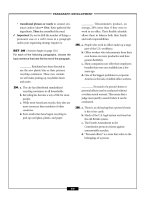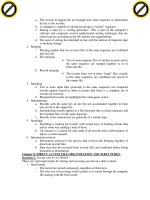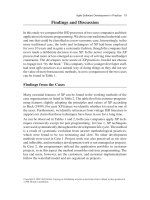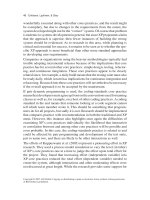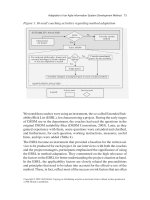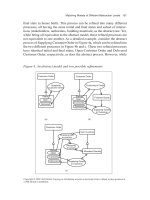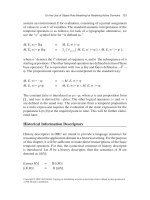Research Issues in Systems Analysis and Design, Databases and Software Development phần 5 ppsx
Bạn đang xem bản rút gọn của tài liệu. Xem và tải ngay bản đầy đủ của tài liệu tại đây (569.04 KB, 32 trang )
Matching Models of Different Abstraction Levels 101
Copyright © 2007, IGI Global. Copying or distributing in print or electronic forms without written permission
of IGI Global is prohibited.
nal state (a house built). This process can be rened into many different
processes, all having the same initial and nal states and subset of interac-
tions (stakeholders, authorities, building materials) as the abstract one. Yet,
while being all equivalent to the abstract model, these rened processes are
not equivalent to one another. As a detailed example, consider the abstract
process of Supplying Customer Order in Figure 4a, which can be rened into
the two different processes in Figure 4b and c. These two rened processes
have identical initial and nal states, Open Customer Order and Delivered
Customer Order, respectively, as does the abstract process. However, while
Figure 4. An abstract model and two possible renements
Customer Order
Supplying
Customer Order
Status
Open
Delivered
(a)
Customer Order
Producing to Order
Finished Goods
Supplying Goods
to Customer
Status
Open
In process
Delivered
(b)
Customer Order
Checking Item
Availability
Item Inventory
Allocated Quantity
Allocating
Inventory
Supplying Goods
to Customer
Status
Open
In process
Delivered
(c)
102 Soffer, Reinhartz-Berger, & Sturm
Copyright © 2007, IGI Global. Copying or distributing in print or electronic forms without written permission
of IGI Global is prohibited.
both processes can be considered equivalent to the abstract model, they are
not equivalent to one another (in their internal division into subprocesses,
additional inputs and outputs, etc.). It is therefore easier to formulate a neces-
sary condition rather than a necessary and sufcient condition for renement
equivalence of processes.
Observation 3: Let m1 be a model portion in which process A transforms an
initial state s
1
into a nal state s
2
. Let E1 be the set of entities directly linked
to A in m1. Let m2 be a model portion that renes m1. Then m2 consists of
a path P and a set E2 of entities that are directly linked to the entities of P so
that P is from an initial state s
1
to a nal state s
2
and E1 ⊆ E2.
Note that the initial and nal states are not necessarily explicitly represented
in an abstract model, in which case the inputs and outputs of the process
should be considered in a similar manner to the states.
Observation 3 provides a necessary condition that might not be sufcient for
the identication of equivalence. When the lower level model is a result of an
instantiation operation of a domain model, its entities are assigned roles that
correspond to domain-model entities. In other cases, we need a way to relate
the subprocesses in a rened model to a process in the abstract model. For
that purpose, we note that it is likely that at least one of the subprocesses in
a rened model bears a name that can be identied as similar to the general
process’ name as appears in the abstract model. Such resemblance can be
detected by existing afnity detection techniques, which are not the focus
of this chapter. This can be explained by a tendency to name the process in
the abstract model after the main activity that constitutes the essence of the
process. In fact, such tendency is not unique to process models. Suggesting
a semiautomatic procedure for abstracting a database schema, Castano et
al. (1998) refer to a “representative” element of the detailed schema, whose
name should be given to the generalizing element in the abstracted schema.
When rening an abstract process to lower abstraction levels, details of other
activities are revealed. In the example of Figure 4, Supplying Goods to Cus-
tomer can be identied as similar to Supplying Customer Order.
In such cases, we expect the rened model to include a path from the initial
state to the similarly named process (or, in ADOM-based models, to the pro-
Matching Models of Different Abstraction Levels 103
Copyright © 2007, IGI Global. Copying or distributing in print or electronic forms without written permission
of IGI Global is prohibited.
cess whose role corresponds to the process in the domain model) and to the
nal state. A path is also expected to relate the process to other entities that
interact with it in the higher-abstraction-level model. If such paths exist in a
detailed model, and if they are equivalent to the links of the abstract model,
than the detailed model can be considered as a renement of the abstract one.
Observation 4 indicates a condition under which a path that may include a
number of processes and objects or states is considered as equivalent to a
specic type of procedural link.
Observation 4: Let A be an object or a state of an object, B be a process,
and P be a path between A and B. Let l be the procedural link by which A is
related to P, then P ≅ l.
Note that the direction of the path can be from the object to the process or
backward, depending on the specic links involved.
Observation 4 can be justied when abstracting the entire path (processes
and objects) to a process (named after its representative activity, B). The link
that determines the nature of the interaction between this abstracted process
and the object is the link relating the object to the path. In the example of
Figure 4b and c, the path from the state Open of Customer Order Status to
Supplying Goods to Customer is equivalent to the direct link from Open to
Supplying Customer Order in 4a.
Observation 4 provides a sufcient condition for identifying renement
equivalence. However, this condition, though sufcient, is not a necessary
one. It is based on the assumption, discussed above, that the abstract process is
named after its main activity. This assumption is not necessarily always true.
For example, a production process can be rened into processes of cutting,
drilling, milling, and so forth. In such cases, the path between the initial and
nal states in the abstract model has to be matched against the path in the
detailed model. That path can be decomposed into individual links for this
purpose. As explained above, when application-model processes bear roles
that classify them as corresponding to domain-model processes, the nam-
ing difculty does not exist. Thus, Observation 4 can conclusively identify
renement equivalence.
104 Soffer, Reinhartz-Berger, & Sturm
Copyright © 2007, IGI Global. Copying or distributing in print or electronic forms without written permission
of IGI Global is prohibited.
Tracking Renement Equivalence
The previous section identied conditions that enable the detection of rene-
ment equivalence. When an application model is validated against a domain
model, the following steps can be taken: (a) The names of the entities that
have a role assigned to them in the application model are replaced by their
roles, (b) satisfaction of the multiplicity constraints specied in the domain
model is determined, and (c) the links among the entities in the domain model
are matched by corresponding links in the application model. In case such
corresponding link is not found, an equivalent path is searched for between
the source entity and the destination entity of the link.
This section describes a rule-based algorithm that identies renement-
equivalent paths with respect to a given link type. The algorithm is basically
a path-searching algorithm applying rules, which follow the discussion and
observations of the previous section, to assure that the path found is indeed
equivalent to the link being matched.
Searching for an Equivalent Path
Consider a pair of OPDs <A, D>, where A is the application model and D is
the domain model being matched. Assume A is searched for a path between
two entities that are directly related in D. The steps of the search shall rst
be informally described, and then specied formally. Each step of the search
partitions A into two sets of entities: One is the set of entities to which a path
from the source entity is already established, and the other is the set of entities
that are not yet explored. Starting from the source entity, each step follows a
link and moves one entity from the unexplored set to the set of entities that
are connected to the source. The choice of link to be followed is based on the
search rules, whose details are given below. The steps repeat until a direct
link is found from the connected set of entities to the destination entity, or
until all the links have been exhausted and it is clear that the searched-for
path does not exist. The algorithm seeks to establish the existence of a path
that is not necessarily the shortest path, hence no backtracking is performed
and the number of steps is at most the number of entities in A minus one.
The formal specication of the search applies to the following notation:
Matching Models of Different Abstraction Levels 105
Copyright © 2007, IGI Global. Copying or distributing in print or electronic forms without written permission
of IGI Global is prohibited.
s: the source entity of the link in D whose equivalent path is being searched
for in A.
d: the destination entity of the link in D whose equivalent path is being
searched for in A
• L
M
(e
1
, e
2
): Let e
1
and e
2
be entities; then L
M
(e
1
, e
2
) is a Boolean variable
whose TRUE value indicates the existence of a direct link from e
1
to e
2
in model M (M is either the application model A or the domain model
D).
• Link
M
(S
1
, S
2
): Let S
1
and S
2
be nonoverlapping sets of entities in model
M; then Link
M
(S
1
, S
2
) is an indicator expressing the existence of a direct
link from an entity in S
1
to an entity in S
2
.
1 2
M
Link (S , S ) =
0 otherwise
11 if e∃ ∈
2
1 2S , S ,e ∈
1 2
M
such that L ( , ) TRUEe e =
• S
M
: the set of entities in model M
• C
i
(M, s): the set of entities in model M to which a path from s has been
found until the i
th
step of the search
• U
i
(M, s): The set of entities in model M whose relationship with s has
not yet been investigated by the i
th
step of the search
In the context of the application model, C
i
(A, s) and U
i
(A, s) partition S
A
so
that at each step i of the search, S
A
= C
i
(A, s) + U
i
(A, s) + {d}. In other words,
each entity in A belongs either to the set of entities that have already been
established as linked to s (including s itself) or to the set of entities whose
relationship with s is unknown yet, or to the set that holds d only.
Lemma: Let an application model A be searched for a path from s to d at
the i
th
step of the search. A path from s to d exists only if Max [Link
A
(C
i
(A,
s), {d}), Link
A
(C
i
(A, s), U
i
(A, s))*Link
A
(U
i
(A, s),{d})] = 1.
Proof: Assume a path exists. It can lead from C
i
(A, s) directly to d, then
Link
A
(C
i
(A, s),{d}) = 1. Otherwise, it leads from C
i
(A, s) to some entity
106 Soffer, Reinhartz-Berger, & Sturm
Copyright © 2007, IGI Global. Copying or distributing in print or electronic forms without written permission
of IGI Global is prohibited.
e∈U
i
(A, s) and from e to d. Then Link
A
(C
i
(A, s), U
i
(A, s)) = 1 and Link
A
(U
i
(A,
s), {d}) = 1.
Assume a path does not exist. Then Link
A
(C
i
(A,s),{d}) = 0 and the follow-
ing are true:
1. If Link
A
(C
i
(A, s), U
i
(A, s)) = 1, then Link
A
(U
i
(A, s),{d}) = 0.
2. If Link
A
(U
i
(A, s),{d}) = 1, then Link
A
(C
i
(A, s), U
i
(A, s)) = 0.
Note that the above lemma is one sided; that is, it does not imply that if Max
[Link
A
(C
i
(A, s), {d}), Link
A
(C
i
(A, s), U
i
(A, s))*Link
A
(U
i
(A, s),{d})] = 1,
then a path exists. Rather, this is a necessary condition for the existence of
such a path.
The initial state of the search is C
0
(A, s) = s, U
0
(A, s) = S
A
– {s, d}. At each
step, if the condition specied in the lemma is satised, one entity is moved
from U
i
(A, s) to C
i
(A, s) by following a link, implying that a relation of this
entity to s is established. The steps repeat until either a path is found, that
is, Link
A
(C
i
(A, s),{d}) = 1, or the condition of the lemma is not satised;
that is, the searched-for path does not exist. The search rules ensure that the
found path is equivalent to the link being searched for.
Figure 5 species the equivalence path search algorithm. This algorithm
employs the following operations.
Figure 5. Equivalent path search algorithm
Current = s
Fold_Structure (d)
Exclude_Links
Do while (Link
A
(C
i
(A, s),U
i
(A, s))*Link
A
(U
i
(A, s),{d}) = 1)
AND (Link
A
(C
i
(A, s),{d}) <> 1)
If Link_Type is procedural then Fold_Structure(Current)
Exclude_Links
Verify_Equival ence
If Link_Type is structural then Compute_Cardinality
Select_Entity
End Do
If (Link
A
(C
i
(A, s),{d}) = 1) AND (Path_Cardinality =
Link_Cardinali ty) AND (Condition) then Path_Found =
TRUE
Else Path_Found = FALSE
Matching Models of Different Abstraction Levels 107
Copyright © 2007, IGI Global. Copying or distributing in print or electronic forms without written permission
of IGI Global is prohibited.
Fold_Structure (entity): A folding operation of structural relations in OPM
is an abstraction operation in which a detailed OPD portion, including struc-
tural relations such as characterization, aggregation, and specialization, is
replaced by an OPD portion of a higher abstraction level. The entities that
provide the structure details of the entity being folded (which is the param-
eter of this operation) are not shown in the abstracted OPD. Other entities,
which are originally related to the structure details, are related directly to
the folded entity.
This operation is employed only when the link, whose equivalent path is
searched for, is a procedural link. Its role is to replace paths created through
renement of structure by their equivalent procedural links on the basis of
Observation 2.
Exclude_Links: This operation excludes links that cannot be included in
the path. Links can be excluded from the search for three reasons. The rst
reason is that they cannot be part of the path according to the search rules,
in which case they are excluded at the beginning of the search. The second
reason is that their direction is opposite of the search direction. At every
step of the search, the unidirectional links from the entities of U
i
(A, s) to the
entities of C
i
(A, s) are excluded from the search. The last reason applies to
inheritance (is-a) links, which may be included in a path in both directions,
from the special to the general as well as the other way. When going up the
relation, the links to other specializations of the general entity cannot be
included in the path.
Select_Entity: At every step of the search, all the links from the entities of
C
i
(A, s) to the entities of U
i
(A, s) are arranged according to priorities dened
by the search rules. The rst link according to this order is selected and the
entity it relates to is moved to C
i
(A, s) and becomes the Current entity.
Verify_Equivalence: The search rules specify for a given link the link type
that must be included in the path and its required position (at the source, at
the destination, or anywhere in the path). If the required position is at the
source or destination of the path, then all the links from s or to d (respectively),
which are not of the mandatory type (i.e., are not of the type that must be in
that position in the path in order to preserve the nature of the interaction), are
excluded from the search at the rst step by the Exclude_Links operation.
108 Soffer, Reinhartz-Berger, & Sturm
Copyright © 2007, IGI Global. Copying or distributing in print or electronic forms without written permission
of IGI Global is prohibited.
As a result, a Boolean variable Condition is assigned a TRUE value. If the
required position is anywhere in the path, the Condition is veried by a set
of indicators EC
e
, dened next.
Let e be an entity in C
i
(A, s); then EC
e
= 1 if and only if a link of the manda-
tory type is in the path from s to e.
Starting at EC
s
= 0, and letting e be moved from U
i
(A, s) to C
i
(A, s) through
a link of type t from an entity a∈C
i
(A, s), then:
1 if (EC 1) or ( is of mandatory type)
EC
0 otherwise
a
e
t=
=
When a path is found, EC
d
= 1 implies that it includes at least one link of the
mandatory type (according to the conditions specied by the search rules),
in which case Condition = TRUE.
Compute_Cardinality: This operation is performed only when structural
relations are searched for. The cardinality of a link is dened as <SL, SU,
DL, DU>, where SL is the source lower participation constraint, SU is the
source upper participation constraint, DL is the destination lower participation
constraint, and DU is the destination upper participation constraint.
Let e be an entity in C
i
(A, s); then the aggregated cardinality of the path from
s to e is denoted by <SL
e
, SU
e
, DL
e
, DU
e
>, where s holds <1, 1, 1, 1>.
Let a be moved to C
i
(A, s) through a link whose cardinality is <SL, SU, DL,
DU> from entity e∈C
i
(A, s), then SL
a
= SL
e
* SL, SU
a
= SU
e
* SU, DL
a
=
DL
e
* DL, DU
a
= DU
e
* DU.
For example, assume an item is supplied by zero to three suppliers, a sup-
plier has one to two contact persons, and a supplier can supply one or more
(1 m) items. The aggregated cardinality of the path between an item and a
purchasing contact person is <1, m, 0, 6>.
Search Rules
The search for an equivalent path employs rules of two types: link selection
rules and equivalence conditions. Both rule types are dened for each type
of link in OPM. A link selection rule denes the types of links that can be
Matching Models of Different Abstraction Levels 109
Copyright © 2007, IGI Global. Copying or distributing in print or electronic forms without written permission
of IGI Global is prohibited.
included in an equivalent path and provides searching priorities for the search
algorithm. It is applied by the Exclude_Links operation, which excludes all
the irrelevant links from the search, and by the Select_Entity operation, which
uses the priorities given for selecting the entity to be moved from U
i
(A, s) to
C
i
(A, s). An equivalence condition denes conditions for a path to be equiva-
lent to a link of a certain type. It is employed by the Verify_Equivalence and
Exclude_Links operations. Conditions may specify link types that must be
included in a path and their required positions that can be at the source of
the path, at its destination, or at any point in the path.
A link selection rule is of the following form:
Link Selection (Link Type): {Set of Types}
Link Type is the type of link to which the path is to be equivalent, while Set
of Types is an ordered set of link types. All the link types in the set can be
included in a path, which is equivalent to Link Type. Their order in the set
determines the priority in which the search algorithm considers links in the
examined OPD when searching for a path.
On the basis of Observation 1, the Set of Types specied for structural link
types satises D
S
= l, where l is the Link Type and S is the Set of Types.
For example, the link selection rule for aggregation, which is a structural link
that denotes a whole-part relation and is dominant with respect to specializa-
tion (is-a) relations only, is:
Link Selection (Aggregation): {Aggregation, Specialization}
For procedural link types, the Set of Types is dened on the basis of Observa-
tion 4. According to this observation, the link that determines the equivalence
is the one related to the source or destination object without restrictions on
the types of links in the path. Hence, the Set of Types for procedural link
types includes all the types of links in OPM.
The order of the types in the Set of Types always sets the relevant Link Type
as the rst priority for the search algorithm. For procedural link types, it lets
the algorithm prefer procedural links over structural ones.
An equivalence condition is of the following form:
110 Soffer, Reinhartz-Berger, & Sturm
Copyright © 2007, IGI Global. Copying or distributing in print or electronic forms without written permission
of IGI Global is prohibited.
Equivalence Condition (Link Type): Mandatory Type must be located at Required Position in the
path
Mandatory Type is a link type that is necessarily included in the path in order
to preserve the nature of the interaction, where Required Position is the exact
position where it should appear (the possible values are at Source Position,
at Destination Position, and Anywhere).
Mandatory Type is, with one exception, the Link Type itself. The exception
is an invocation link, which represents the triggering of a process by the
completion of another process. This can also be modeled as an event created
by the rst process and triggering the second one. In this case, an event link
replaces the invocation link.
For structural link types, the Required Position is Anywhere, since the link
selection rules ensure the dominance of the specic link type with respect
to the links in the path. Hence, their position in the path is of no importance
as long as they are present. For procedural link types, the Required Position,
according to Observation 4, depends on the link type. Links whose direction
is from the object to the process (e.g., instrument links) require the Manda-
tory Type at the source of the path, while links that lead from the process to
the object (e.g., result links, which are unidirectional effect links) require the
Mandatory Type at the destination of the path.
For example, below are the equivalence conditions for aggregation links
(i.e., structural links that denote whole-part relations) and instrument links
(i.e., procedural links that denote input objects that are not changed by the
process; these links are directed from the object to the process).
Equivalence Condition (Aggregation): Aggregation must be located Anywhere in the path
Equivalence Condition (Instrument Link): Instrument Link must be located at Source Position in
the path
As explained above, the two types of rules are based on Observation 1, which
addresses structural links when structure is rened, and on Observation 4,
which addresses procedural links when behavior is rened. Observation 2,
which addresses procedural links when structure is rened, is not applied as
part of the rule base, but is taken into account by the Fold_Structure opera-
tion performed by the search algorithm.
Matching Models of Different Abstraction Levels 111
Copyright © 2007, IGI Global. Copying or distributing in print or electronic forms without written permission
of IGI Global is prohibited.
Exemplifying the Equivalent-Path Search Algorithm
The algorithm steps are illustrated by an example given in Figure 6: Figure
6a is part of a domain model, while Figure 6b is an application model that
should be matched against the domain model. The domain model species
the main concepts as well as their multiplicity constraints. For example, Pro-
Figure 6. Renement equivalence example
(b)
(a)
1.m
1 1
1 1
1.m
112 Soffer, Reinhartz-Berger, & Sturm
Copyright © 2007, IGI Global. Copying or distributing in print or electronic forms without written permission
of IGI Global is prohibited.
duction Order and Issuing to Production are indicated as mandatory single
entities (the 1 1 at the right lower corner of the entities), meaning they must
be instantiated exactly once in any application model of the domain, while
Production Order BOM and Item Stock are indicated as mandatory multiple
entities (the 1 m at the right lower corner of the entities), meaning they must
appear at least once in any application model in the domain. Correspondingly,
some of the application-model entities have roles (at their left upper corner)
that relate them to the domain-model entities, while others are additional ap-
plication-specic entities. Note that the number of role-classied entities in
the application model is consistent with the multiplicity indicators specied
in the domain model for each role.
None of the procedural links specied in Figure 6a appears as a direct link
in Figure 6b. Nevertheless, they are all matched by equivalent paths in the
application model. The domain model species that a process of Issuing to
Production affects the Production Order and the Item Stock, and uses the
Production Order BOM (which species the required materials). In the ap-
plication model, a process of Releasing Production Order precedes Issuing
Figure 7. Search algorithm 1
st
step
Requires
Production Order
POM
Production Order
Order Status
Releasing
Production Order
Kitting List
Issuing to
Production
Specify Details of
Order Documents
Item Stock
Inventory
on Stock
Allocated
Inventory
Matching Models of Different Abstraction Levels 113
Copyright © 2007, IGI Global. Copying or distributing in print or electronic forms without written permission
of IGI Global is prohibited.
Item (whose role is Issuing to Production), using Item Inventory (whose role
is Item Stock) information as well as the item ID and quantities specied by
PO BOM Lines, which are parts of the PO BOM (both have a role of Produc-
tion Order BOM). The process of Releasing Production Order creates Order
Documents (a set of documents, specifying details of the production order, to
be used in the production process) and a Kitting List, which is a list of items
to be prepared in kits before they can be issued to production. The Issuing
Process uses the Kitting List and affects the Item Inventory.
We shall follow the steps of the search algorithm for tracking an equivalent
path that matches the instrument link from Production Order BOM to Is-
suing to Production in the domain model of Figure 6(a) in the application
model of Figure 6(b). Two entities in that model are classied with the role
of Production Order BOM. However, since one is part of the other, we will
use the whole as the source of the searched path, as illustrated in Figures 7
to 10. The search in Figures 7 to 10 is performed after the names of the enti-
ties have been replaced by their roles (whenever they have one), according
to the rst validation step.
Figure 8. Search algorithm 2
nd
step
114 Soffer, Reinhartz-Berger, & Sturm
Copyright © 2007, IGI Global. Copying or distributing in print or electronic forms without written permission
of IGI Global is prohibited.
Step 1 (see Figure 7): C
0
(A, s) includes the source entity, Production Order
BOM (highlighted). The source entity is the Current entity, and a Fold_
Structure(Current) operation is performed. As a result, its structural details
are not seen, and the instrument links originally related to these details are
now related directly to Production Order BOM itself. U
0
(A, s) includes all
the other entities in the model, except the source entity, Production Order
BOM, and the destination entity, Issuing to Production (highlighted). C
0
(A,
s) is linked to U
0
(A, s), which is linked to the destination entity, thus the
condition of the lemma is satised.
Step 2 (see Figure 8): Following the instrument link, C
1
(A, s) includes Re-
leasing Production Order in addition to Production Order BOM. Note that
the equivalence condition of an instrument link requires that the rst move
should be through an instrument link, and it is satised. Two instrument links
that lead to Releasing Production Order are excluded from the search by the
Exclude_Links operation since their direction is opposite of the path direction.
C
1
(A, s) is still linked to U
1
(A, s), which is linked to the destination entity.
Figure 9. Search algorithm 3
rd
step
Matching Models of Different Abstraction Levels 115
Copyright © 2007, IGI Global. Copying or distributing in print or electronic forms without written permission
of IGI Global is prohibited.
Step 3 (see Figure 9): Following the effect link, Order Documents is included
in C
2
(A, s). Note that this is a random choice from the three effect links that
lead from Releasing Production Order. C
2
(A, s) is still linked to U
2
(A, s),
which is linked to the destination entity.
Step 4 (see Figure 10): Following the next effect link from C
2
(A, s), Kit-
ting List is now added to C
3
(A, s). C
3
(A, s) is now linked to the destination
entity, thus establishing a path that meets the equivalence conditions, and is
therefore equivalent to the direct link of the domain model.
Note that Step 3 is actually redundant and could be avoided by a different
choice of link. Nevertheless, by addressing all the links of the C
i
(A, s) set,
the algorithm is able to simply look one step ahead at a time and avoid a
recursive backtracking.
The complexity of the search algorithm is O(|S
A
|), where |S
A
| is the number
of entities in A. The search is performed for each link in D when the models
Figure 10. Search algorithm 4
th
step
116 Soffer, Reinhartz-Berger, & Sturm
Copyright © 2007, IGI Global. Copying or distributing in print or electronic forms without written permission
of IGI Global is prohibited.
are matched. Hence, the complexity of the matching is O(|S
D
|
2
*|S
A
|). Note
that |S
D
| is expected to be signicantly smaller than |S
A
|.
Related Work
Model similarity has been addressed by several disciplines. The ones that
are relevant to this work are the disciplines of reuse and schema analysis
and matching. The difference in abstraction level between matched models
has not, to the best of our knowledge, been explicitly addressed in the reuse
literature. Kim (2001) presents an object-oriented model reuse application in
which an initial model, including classes and nonspecic links, serves as a
basis for retrieving an existing complete model. The retrieved model is then
modied and adapted to the current needs using modication rules, whose
details are not presented. No details are available about how a complete
model is retrieved and evaluated, how this retrieval considers the nonspecic
links of the input model, and how structurally different from each other the
models retrieved are.
Structural similarity plays an important role in the works that deal with ana-
logical reasoning (Massonet & Lamsweerde, 1997; Sutcliffe & Maiden, 1998),
where models designed for a certain domain are applied to other domains by
analogy. The retrieval is based on structural properties of the model and on
semantics, which is based on generalizations. In Sutcliffe and Maiden, the
models to be retrieved include a number of layers, each dealing with different
information types, going from an abstract layer to a detailed one. The match-
ing with the input information interactively follows these layers of specic
information types, and the user is required by the system to provide enough
information to discriminate between existing models. Hence, the structural
similarity deals with models of the same abstraction level. In Massonet and
Lamsweerde, while the entities of an input model are generalized to a higher
level in an is-a hierarchy, their link structure is expected to remain the same
and serves as a basis for structural similarity assessment.
Other works that apply reuse for method engineering (Ralyte & Rolland,
2001) and for enterprise modeling (Chen-Burger et al., 2000) use simple
structural similarity assessment along with semantic similarity based on
afnity (Ralyte & Rolland) or on a generalization hierarchy (Chen-Burger
et al.). The model used by Ralyte and Rolland includes multiple abstraction
Matching Models of Different Abstraction Levels 117
Copyright © 2007, IGI Global. Copying or distributing in print or electronic forms without written permission
of IGI Global is prohibited.
levels. Hence, there might be a match between the abstraction level of a query
model and one of the levels of the reusable models, but it is not explicitly
addressed and veried. None of the above reviewed works relates to model
matching for validation purposes as proposed in this chapter.
Schema-matching literature focuses on the semantic mapping of one schema
to the other. While semantic similarity in the reuse literature is mostly afnity
based, or in some cases relies on is-a hierarchies, semantic matching in the
schema-matching literature sometimes combines the afnity of terms with
structural considerations. Schema matching maps elements of one schema to
elements of another schema rather than compute similarity measures between
the two schemas. Hence, each pair of elements is thoroughly examined and
structural aspects, such as attributes and is-a relations, are taken into account
(Madhavan, Bernstein, & Rahm, 2001; Rahm & Bernstein, 2001; Rodriguez
& Egenhofer, 1999). In some cases, paths are sought where direct links do
not exist (Palopoli et al., 2003). Nevertheless, dealing with schemas means
dealing with a low level of abstraction. Some schemas may be more detailed
than others, and the techniques suggested are aimed at overcoming such
differences rather than at dealing with models that are basically at different
abstraction levels. Typical to this situation is the use of the term “structural
equivalence” of schemas (Algaic & Bernstein, 2001), which relates to a
consistent mapping of schema elements from one schema to another and
backward in the lowest abstraction level. It is dened as structural as opposed
to semantic equivalence, which relates to integrity constraints as well.
The similarity assessment of entities, presented by Rodriguez and Egenhofer
(1999), relates to parts, functions, and attributes of two entity classes. Their
similarity measure uses a function that provides asymmetric values for en-
tity classes that belong to different levels of abstraction. While addressing
single entity classes, they take contextual information into account for the
similarity measurement. However, context information of an entity cannot be
considered equivalent to a view of the entity as a part of a model, including
relationships with other entities.
A more holistic view of schema analysis, including a variety of techniques
for schema abstraction, matching, and reuse, is presented in Castano et al.
(1998). Schema abstraction is an operation in the opposite direction compared
to our discussion of renement operations. The ERD schemas addressed limit
the discussion to structural links only, without addressing the representation
of behavior. Yet, their abstraction operation is consistent with our opposite-
direction renement, and applying the algorithm presented here to their ex-
118 Soffer, Reinhartz-Berger, & Sturm
Copyright © 2007, IGI Global. Copying or distributing in print or electronic forms without written permission
of IGI Global is prohibited.
amples of detailed and abstract schema yields a match. A number of schema
similarity measures are presented there, dealing mainly with semantics and,
to a limited extent, model structure, particularly with attributes. Interestingly
enough, their fuzzy similarity measure is asymmetric and may indicate that
schema a matches schema b to a higher extent than in the other direction.
This is explained as being a result of differences in the abstraction level
between the two schemas.
Our approach can be classied according to the extensive classication of
schema-matching approaches presented by Shvaiko and Euzenat (2005).
It is a structure-level approach (computes mapping elements by analyzing
how entities appear together in a structure), syntactic (interprets the input in
function of its sole structure following some clearly stated algorithm), and
graph based (addressing children, leaves, and relations of entities). However,
this classication does not relate to differences in the abstraction level of
the matched schemas, and this issue is not addressed by any of the works
surveyed there.
In summary, the main contribution of this chapter as compared to related
earlier model-matching works is in explicitly addressing models of different
abstraction levels, representing both the structure and behavior of a domain
of applications.
Conclusion
The reuse of models requires activities that in many cases employ model
matching. In this chapter, we stressed that differences in the abstraction level
are likely to exist between models, specically in the retrieval and validation
activities, and therefore renement equivalence is a better measure than struc-
tural similarity. Renement equivalence is identied when a detailed model
can be considered a renement of a model of a higher abstraction level. In
this chapter we discussed the notion of renement equivalence as an enabler
of validating a detailed application model against an abstract domain model
in the context of the ADOM approach for domain analysis.
The discussion of renement operations and the observations that characterize
their impact on model structure, as well as the search algorithm, address OPM
models. However, ADOM is language independent and can be used with other
modeling languages as well. Other modeling languages are different mainly
Matching Models of Different Abstraction Levels 119
Copyright © 2007, IGI Global. Copying or distributing in print or electronic forms without written permission
of IGI Global is prohibited.
in the separation of structural and behavioral aspects of the modeled domain
(and applications). Yet, the notion of renement equivalence is of relevance
to models independently of the modeling language. Some of the observa-
tions made in this chapter can easily be generalized and become applicable
to other modeling languages. For example, Observation 1, which deals with
the dominance of structural relations in a path, is not specic to OPM only.
Hence, when dealing with models that capture structural information only
(e.g., ERD, UML class diagrams), the algorithm can be applied using the
search rules that relate to structural links only, omitting the Fold_Structure
operation. Regarding the behavioral aspects, generalization is less straight-
forward. In multiview modeling languages, such as UML, consistency among
views might also need consideration.
An equivalent-path search algorithm is, naturally, language specic, and
apparently needs to be developed for each modeling language. However,
the algorithm presented here is mainly a path-searching algorithm, while
specic features of the OPM links are captured by the equivalence rules.
Hence, the main body of the algorithm might be applicable to other model-
ing languages while the unique features of the language might affect mainly
the equivalence rules.
The search algorithm that enables renement-equivalence identication
has been implemented in a reuse application that supports business-process
alignment and gap analysis in the implementation of ERP systems (Soffer et
al., 2005). The application matches abstract enterprise requirement models
with a detailed model of the ERP system, and retrieves the parts that match
the requirements.
Future research should extend the renement-equivalence concept and ap-
ply it to other modeling languages that serve in reuse applications, such as
UML.
References
Algaic, S., & Bernstein, P. A. (2001). A model theory for generic schema
management. In Proceedings of DBPL (LNCS 2397, pp. 228-246).
Berlin, Germany: Springer-Verlag.
120 Soffer, Reinhartz-Berger, & Sturm
Copyright © 2007, IGI Global. Copying or distributing in print or electronic forms without written permission
of IGI Global is prohibited.
Castano, S., De Antonellis, V., Fogini, M. G., & Pernici, B. (1998). Concep-
tual schema analysis: Techniques and applications. ACM Transactions
on Database System, 23(3), 286-333.
Chen-Burger, Y. H., Robertson, D., & Stader, J. (2000). A case-based reason-
ing framework for enterprise model building, sharing and reusing. In
Proceedings of the ECAI Knowledge Management and Organization
Memories Workshop, Berlin, Germany.
Dori, D. (2002). Object process methodology: A holistic systems paradigm.
Heidelberg, Germany: Springer Verlag.
Eckstein, S., Ahlbrecht, P., & Neumann, K. (2001). Increasing reusability
in information systems development by applying generic methods. In
Advanced information systems engineering (LNCS 2068, pp. 251-266).
Berlin, Germany: Springer-Verlag.
Kim, Y. J. (2001). An implementation and design of COMOR system for
OOM reuse. In Active Media Technology, 6
th
International Computer
Science Conference (LNCS 2252, pp. 314-320). Berlin, Germany:
Springer-Verlag.
Lai, L. F., Lee, J., & Yang, S. J. (1999). Fuzzy logic as a basis for reusing
task-based specications. International Journal of Intelligent Systems,
14(4), 331-357.
Madhavan, J., Bernstein, P. A., & Rahm, E. (2001). Generic schema marching
with Cupid. In Proceedings of the VLDB Conference, Rome.
Massonet, P., & Lamsweerde, A. V. (1997). Analogical reuse of requirements
frameworks. In Proceedings of the Third IEEE Symposium on Require-
ments Engineering (RE’97) (pp. 26-37).
Mili, H., Mili, F., & Mili, A. (1995). Reusing software: Issues and research
directions. IEEE Transactions on Software Engineering, 21(6), 528-
561.
OMG. (2006). Meta-object facility (MOF™), version 2.0.
Palopoli, L., Sacca, D., Terracina, G., & Ursino, D. (2003). Uniform techniques
for deriving similarities of objects and subschemes in heterogeneous
databases. IEEE Transactions on Knowledge and Data Engineering,
15(2), 271-294.
Peleg, M., & Dori, D. (1999). Extending the object-process methodology
to handle real time systems. Journal of Object Oriented Programming,
11(8), 53-58.
Matching Models of Different Abstraction Levels 121
Copyright © 2007, IGI Global. Copying or distributing in print or electronic forms without written permission
of IGI Global is prohibited.
Pernici, B., Mecella, M., & Batini, C. (2000). Conceptual modeling and
software components reuse: Towards the unication. In Information
systems engineering: State of the art and research themes (pp. 209-220).
London: Springer-Verlag.
Rahm, E., & Bernstein, P. A. (2001). A survey of approaches to automatic
schema matching. The VLDB Journal, 10(4), 334-350.
Ralyte, J., & Rolland, C. (2001). An assembly process model for method
engineering. In Advanced information systems engineering (LNCS
2068, pp. 267-283). Berlin, Germany: Springer-Verlag.
Reinhartz-Berger, I., Dori, D., & Katz, S. (2002). Open reuse of component
designs in OPM/Web. In Proceedings of the 26
th
Annual International
Computer Software and Applications (pp. 19-24).
Reinhartz-Berger, I., & Sturm, A. (2004). Behavioral domain analysis: The
application-based domain modeling approach. In Proceedings of the 7
th
International Conference on the Unied Modeling Language (UML2004)
(LNCS 3273, pp. 410-424). Berlin, Germany: Springer-Verlag.
Rodriguez, M. A., & Egenhofer, M. J. (1999). Putting similarity assessments
into context: Matching functions with the user’s intended operations.
In Proceedings of CONTEXT’99 (LNAI 1688, pp. 310-323). Berlin,
Germany: Springer-Verlag.
Shvaiko, P., & Euzenat, J. (2005). A survey of schema-based matching ap-
proaches. Journal on Data Semantics, 4, 146-171.
Soffer, P. (2005). Renement equivalence in model-based reuse: Overcom-
ing differences in abstraction level. Journal of Database Management,
16(3), 21-39.
Soffer, P., Golany, B., & Dori, D. (2003). ERP modeling: A comprehensive
approach. Information Systems, 28(6), 673-690.
Soffer, P., Golany, B., & Dori, D. (2005). Aligning an ERP system with en-
terprise requirements: An object-process based approach. Computers
in Industry, 56(6), 639-662.
Soffer, P., Golany, B., Dori, D., & Wand, Y. (2001). Modelling off-the-shelf
information systems requirements: An ontological approach. Require-
ments Engineering, 6(3), 183-198.
Sturm, A., Dori, D., & Shehory, O. (2006), Domain modeling with object-
process methodology. In Proceedings of the Eighth International Con-
ference on Enterprise Information Systems.
122 Soffer, Reinhartz-Berger, & Sturm
Copyright © 2007, IGI Global. Copying or distributing in print or electronic forms without written permission
of IGI Global is prohibited.
Sturm, A., & Reinhartz-Berger, I. (2004). Applying the application-based
domain modeling approach to UML structural views. In Proceedings
of the 23
rd
International Conference on Conceptual Modeling (ER2004)
(LNCS 3288, pp. 766-779). Berlin, Germany: Springer-Verlag.
Sutcliffe, A., & Maiden, N. A. (1998). The domain theory for requirements
engineering. IEEE Transactions on Software Engineering, 24(3), 174-
196.
Wenyin, L., & Dori, D. (1998). Object-process diagrams as an explicit al-
gorithm specication tool. Journal of Object-Oriented Programming,
12(2), 52-59.
Zhang, Z., & Lyytinen, K. (2001). A framework for component reuse in a
meta-modelling-based software development. Requirements Engineer-
ing, 6(2), 116-131.
On the Use of Object-Role Modeling for Modeling Active Domains 123
Copyright © 2007, IGI Global. Copying or distributing in print or electronic forms without written permission
of IGI Global is prohibited.
Chapter V
On the Use of Object-Role
Modeling for Modeling
Active Domains
Patrick van Bommel,
Radboud University Nijmegen, The Netherlands
Stijn Hoppenbrouwers,
Radboud University Nijmegen, The Netherlands
Erik Proper,
Radboud University Nijmegen, The Netherlands
Theo van der Weide,
Radboud University Nijmegen, The Netherlands
Abstract
This chapter is about how the object-role modeling (ORM) language and ap-
proach can be used for the integration, at a deep and formal level, of various
domain modeling representations and viewpoints, with a focus on the model-
ing of active domains. The authors argue that ORM is particularly suited for
124 van Bommel, Hoppenbrouwers, Proper, & van der Weide
Copyright © 2007, IGI Global. Copying or distributing in print or electronic forms without written permission
of IGI Global is prohibited.
enabling such integration because of its generic conceptual nature; its useful,
existing connection with natural language and controlled languages; and its
formal rigor. They propose the logbook paradigm as an effective perspective
in active domains modeling and for the derivation of domain grammars. They
show how standard ORM can be extended to an object-role calculus (ORC),
including temporal concepts and constraints that enable the modeling of
active domains. A suggestion for graphical representation is also provided.
The authors hope to contribute to the integration of domain models and
viewpoints in an academic and educational context rather than proposing
ORM and ORC as new modeling tools in an industrial setting.
Introduction and Background
Conceptual modeling methods such as ER (Chen, 1976), EER (Elmasri &
Navathe, 1994; Gogolla, 1994), KISS (Kristen, 1994), NIAM (Nijssen &
Halpin, 1989), OOSA (Embley, Kurtz, & Woodeld, 1992), and object-role
modeling (ORM; Halpin, 2001) have traditionally been developed with the
aim of providing conceptual models of database structures. More recently,
however, such modeling methods have shown their use for more generic
modeling (of the ontology) of domains, leading to models capturing the
concepts of a domain in general, as well as an associated language to express
rules (such as business rules) governing the behavior of the domain (Proper,
Bleeker, & Hoppenbrouwers, 2004; Proper, Hoppenbrouwers, & Weide,
2005; Spyns, 2005; Spyns, Meersman, & Jarrar, 2002).
The above mentioned modeling methods typically take a natural-language-
based perspective to the domain to be modeled. In this perspective, the
resulting model is regarded as a domain grammar describing the allowed
communication about a domain (the universe of discourse). This way of
thinking dates back to the ISO (1987) report Concepts and Terminology for
the Conceptual Schema and the Information Base, and it is at the base of the
modeling methods mentioned. A key advantage of such methods is that hav-
ing a domain grammar at one’s disposal enables validation of the model by
domain experts since the model can be validated in terms of statements that
are close to the language used by these experts. Also, formal approaches to
conceptual modeling imply adherence to a formal language; domain gram-
mars (closely resembling signatures in formal logic) are an excellent basis
for further formal modeling.
On the Use of Object-Role Modeling for Modeling Active Domains 125
Copyright © 2007, IGI Global. Copying or distributing in print or electronic forms without written permission
of IGI Global is prohibited.
A basic domain grammar can be extended to cover rules (constraints) govern-
ing the structure and behavior of or in the domain. When combined with a
reasoning mechanism, such a rule language becomes a domain calculus. In
the case of ORM, a domain calculus has been presented in the form of Lisa-
D (Hofstede, Proper, & Weide, 1993), a formalization of RIDL (Meersman,
1982). In Proper (1994a) and Bloesch and Halpin (1996), a more practical
version was introduced (that is, from an implementation point of view) called
ConQuer. What Lisa-D and ConQuer have in common is that they exploit
the natural character of the domain grammar in the construction of rules
(Hofstede, Proper, & Weide, 1997). As a result, the formulation of rules,
as well as chains of reasoning expressed by means of these rules, closely
resembles natural language. As mentioned, this supports validation of the
models produced.
In the use of domain modeling methods, we observe three important trends
that fuel our ongoing research activities. First, more and more organizations
strive for more mature levels of system development (Paulk, Curtis, Chrissis,
& Weber, 1993). One of the steps toward maturity involves better dening
of development processes in order to make them more repeatable. This also
applies to modeling processes. Some organizations now indeed strive to
make modeling processes more explicitly dened with the aim of achieving
more repeatable results.
Modeling methods such as ORM (Halpin, 2001), NIAM (Nijssen & Halpin,
1989), OOSA (Embley et al., 1992), KISS (Kristen, 1994), and DEMO
(Reijswoud & Dietz, 1999) not only feature a way of modeling, but also
have a fairly well-dened and explicit way of working based on natural-lan-
guage analysis. The way of working (Wijers & Heijes, 1990) of a method is
concerned with processes, guidelines, heuristics, and so forth, which are to
be used in the creation of models, as opposed to its way of modeling, which
refers to the syntax and semantics of the language in which the models are
to be expressed. A well-dened and explicit way of working helps achieve
a dened and more repeatable modeling process. Even though the ORM
conceptual schema design procedure already provides clear guidelines for
creating domain models in a repeatable fashion, more work in terms of sound
theoretical underpinning and automated support of the (detailed steps of
the) modeling process is still called for (Hoppenbrouwers, Proper, & Weide,
2005b) and is one of the main goals underlying our ongoing research. This
is not our main focus here, but it is a partial explanation for our preference
for ORM.

